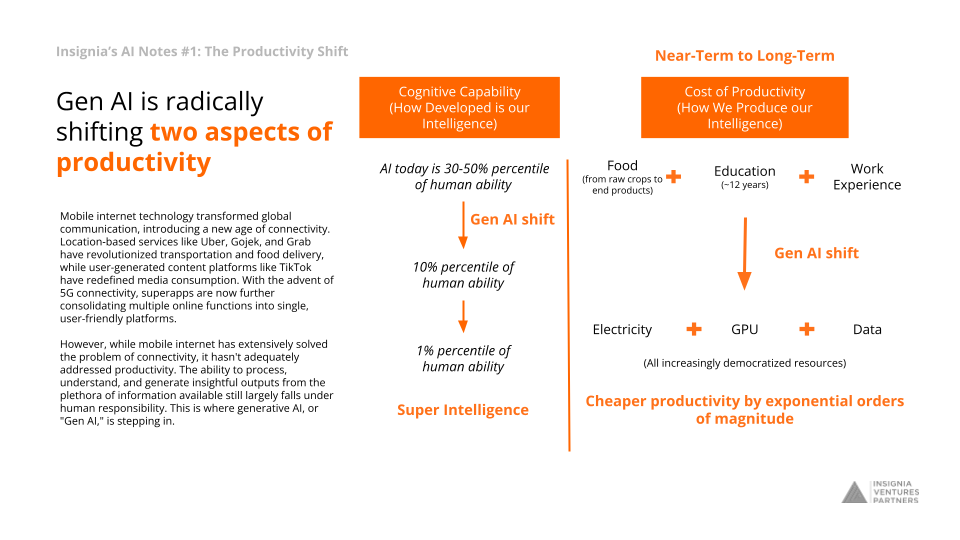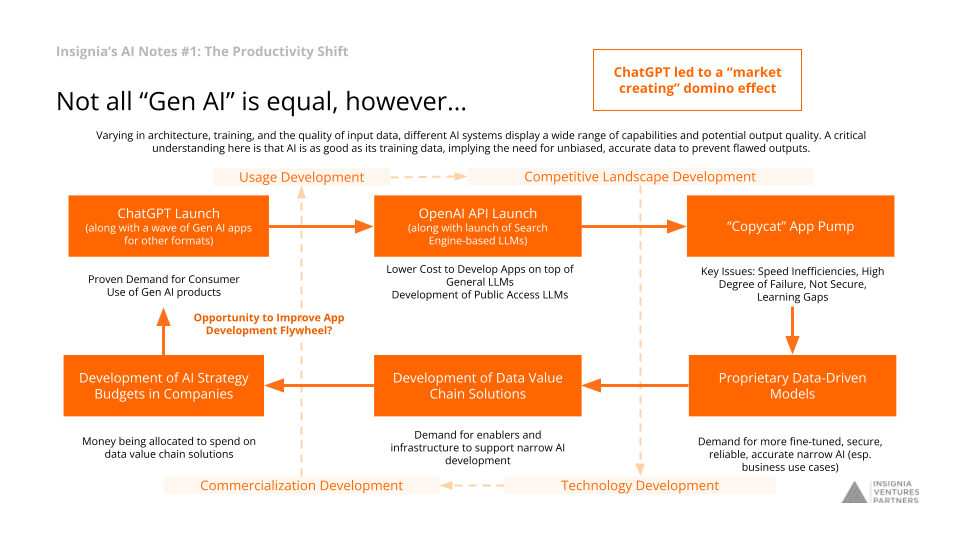Mobile internet technology transformed global communication, introducing a new age of connectivity. Location-based services like Uber, Gojek, and Grab have revolutionized transportation and food delivery, while user-generated content platforms like TikTok have redefined media consumption. With the advent of 5G connectivity, superapps are now further consolidating multiple online functions into single, user-friendly platforms.
However, while mobile internet has extensively solved the problem of connectivity, it hasn’t adequately addressed productivity. The ability to process, understand, and generate insightful outputs from the plethora of information available still largely falls under human responsibility. This is where generative AI, or “Gen AI,” is stepping in.
 Emergence and potential of generative AI
Emergence and potential of generative AI
Gen AI, employing machine learning algorithms, learns from vast data pools and generates new content based on this learning. These capabilities permit Gen AI to not only analyze but also create, innovate, and assist in decision-making, potentially revolutionizing productivity.
Two pivotal aspects that Gen AI is shifting are cognitive capability (the development of our intelligence) and cost of productivity (how we produce our intelligence).
Currently, AI’s cognitive capability sits around the 30-50% percentile of human ability. With Gen AI, this could go to the 10% percentile. In the future, there is clearer potential for the development of super intelligence, encroaching on the 1 percent percentile of human ability.
In terms of productivity costs, today, producing intelligence takes substantial resources: food, education spanning about 12 years, and work experience. The Gen AI shift significantly alters this equation, necessitating primarily electricity, GPU, and data – all increasingly democratized resources. This shift results in exponentially cheaper productivity.
However, not all Gen AI is equal. Varying in architecture, training, and the quality of input data, different AI systems display a wide range of capabilities and potential output quality. A critical understanding here is that AI is as good as its training data, implying the need for unbiased, accurate data to prevent flawed outputs.

Gen AI and the “market creating” domino effect
The launch and usage proliferation of ChatGPT and other Gen AI apps for other media formats has sparked a “market creating” domino effect, demonstrating the potential demand for similar AI applications. The release of the OpenAI API along with other LLMs has made developing such intelligence more cost-effective from an app builder’s standpoint.
This has led to an explosion of “copycat” apps, although many have been met with failure due to lack of security and reliability. This, in turn, has stimulated a demand for more fine-tuned, secure, reliable, and accurate narrow AI, particularly for business use cases, or proprietary data-driven models.
As a response to this increasing demand, a significant focus is now on developing the data value chain. We are witnessing a shift in budget allocation, with more money being earmarked for AI strategy and investment in data value chain solutions.
Stay tuned next week for our look into what exactly the development of the data value chain can do to catalyze generative AI use cases and on a larger scale, shape the way companies (not just gen AI companies) are built in the future.
Despite its immense potential, Gen AI isn’t a panacea for all productivity inefficiencies. It is crucial to remember that while Gen AI can automate various tasks, it cannot entirely replace human creativity, empathy, and critical thinking – the “human touch.” As we integrate Gen AI more deeply into our lives, we must remain mindful of its limitations and potential pitfalls, striking a balance between leveraging the benefits of AI and preserving the irreplaceable value of human ingenuity.
 Paulo Joquiño is a writer and content producer for tech companies, and co-author of the book Navigating ASEANnovation. He is currently Editor of Insignia Business Review, the official publication of Insignia Ventures Partners, and senior content strategist for the venture capital firm, where he started right after graduation. As a university student, he took up multiple work opportunities in content and marketing for startups in Asia. These included interning as an associate at G3 Partners, a Seoul-based marketing agency for tech startups, running tech community engagements at coworking space and business community, ASPACE Philippines, and interning at workspace marketplace FlySpaces. He graduated with a BS Management Engineering at Ateneo de Manila University in 2019.
Paulo Joquiño is a writer and content producer for tech companies, and co-author of the book Navigating ASEANnovation. He is currently Editor of Insignia Business Review, the official publication of Insignia Ventures Partners, and senior content strategist for the venture capital firm, where he started right after graduation. As a university student, he took up multiple work opportunities in content and marketing for startups in Asia. These included interning as an associate at G3 Partners, a Seoul-based marketing agency for tech startups, running tech community engagements at coworking space and business community, ASPACE Philippines, and interning at workspace marketplace FlySpaces. He graduated with a BS Management Engineering at Ateneo de Manila University in 2019.
This article is the first part of a series on AI and was originally published on the Insignia Business Review.
TechNode Global INSIDER publishes contributions relevant to entrepreneurship and innovation. You may submit your own original or published contributions subject to editorial discretion.

